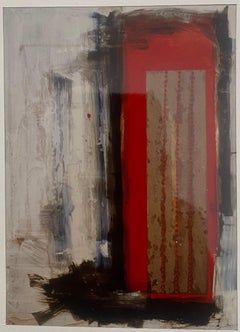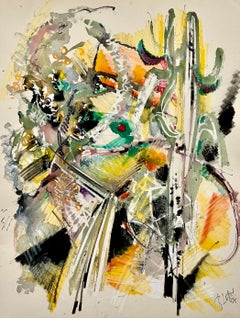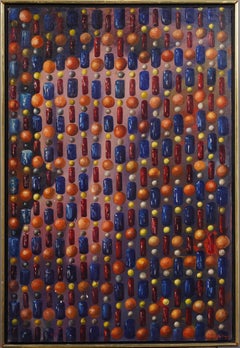Artist: Paul Van Hoeydonck – Belgian (1925 - )
Title: Planete
Year: 1961
Medium: Mixed media
Size: 48 x 48 inches.
Signature: Signed, dated, titled on the reverse
Condition: Good
This mid century work by Paul Van Hoeydonck is a direct and strong composition, like so many of Van Hoeydonck’s Planete works. It measures 48” x 48” and is a mixed media composition. It is a composition on masonite or a similar material. There is flat black and gloss black paint. Perhaps the gloss is lacquer. The surface is highly textured. The black areas have small finish nails, lying flat, attached to the surface. The other areas have sand or some other particulate in the paint. It is signed, titled and dated on the reverse. The date looks like “1961” but it could be “1969.” Please see pictures. Stylistically, this work looks very much like his work from 1961-1962. The piece is in good condition. There is a faint scratch in the upper left and some very small chips on the edges. Please see pictures. There also might be very, very light surface dirt throughout.
Please refer to the artist's website as well as Whitford Gallery for extensive biographies of the artist.
Public collections include
Galleria Comunale d’Arte Moderna, Rome
Israel Museum, Jerusalem
Koninklijk Museum voor Schone Kunsten, Antwerp
Museum of Modern Art, New York
Stedelijk Museum, Ostende
Van Abbemuseum, Eindhoven
The Solomon R. Guggenheim Museum, New York
PAUL VAN HOEYDONCK BIOGRAPHY
1925
Born in Antwerp, Belgium
1945-51
Graduated in History of Art and Archaeology in Antwerp, Belgium.
1952
First solo-exhibition, figurative paintings, Gallery Buyle, Antwerp, Belgium. (OMS)
Figurative paintings, Gallery Unicum, Bruges, Belgium.(OMS)
Figurative paintings, Au Cheval de Verre, Brussels, Belgium.(OMS)
1953
One-man show figurative paintings, Gallery Unicum, Bruges, Belgium.
"Open Air Party", Driekoningen Castle, Beernem, Belgium.(GE)
"Salon Quadriennal de Belgique" Liège, Belgium.(GE)
1954
Creates Coloured Geometrical Abstract paintings
Gilbert Swimberge and Paul Van Hoeydonck, Galerie Théâtre du Poche, Brussels, Belgium.(GE)
"Zomersalon Salon d'été" Gallery Unicum, Bruges, Belgium.(GE)
"Salon quadriennal des Beaux-Arts" Ghent, Belgium.(GE)
1955
Gallery Dutilleul, Brussels, Belgium.(OMS)
1956
Co-founder of art group “FORMES”
"Lauréats du prix Jeune Peinture Belge", Palais du Beaux-Arts, Brussels, Belgium.(GE)
Diamond among the works 'distinguished by the jury'
"La peintres du groupe Formes" Cercle Jean Jaurès, Salle de l'Académie de musique, Morlanwelz.(GE)
"Défense du petit format", Gallery Saint-LaurentBrussels, Belgium.(GE)
Gallery Saint Laurent, Brussels, Belgium.(OMS)
1957
Created first monochrome collages.
"Salon national du meuble social moderne" Museum voor Sierkunst, Ghent, Belgium.(GE)
"Lauréats du Prix Jeune Peinture" Société Royale des Beaux-Arts, Verviers, Belgium.(GE)
Gallery le rouge et le noir, Charleroi, Belgium.(GE)
"Groupes" Gallery Accent, Antwerp, Belgium.(GE)
"Défense du petit format" Gallery Saint Laurent, Brussels, Belgium.(GE)
"Summer Exhibition" Gallery Accent, Antwerp, Belgium.(GE)
"Paul Van Hoeydonck" Gallery Saint Laurent, Brussels, Belgium.(OMS)
"Peintres belges inspirés par l'Espagne" Gallery Giroux, Brussels, Belgium.(GE)
1958
Creates first monochrome light works with the introduction of small plexiglass structures.
"Paul Van Hoeydonck" Gallery Accent, Antwerp, Belgium.(OMS)
"Oeuvres graphiques" Gallery Saint-Laurent, Brussels
Exhibition G58 with Georges Van Tongerloo at Castle Middelheim Museum, Antwerp Belgium.(GE)
Co-founder of the G58 Hessenhuis group in Antwerp.
Opening Exhibition G58, Hessenhuis, Antwerp, Belgium.(GE)
Participation at the World Exhibition Brussels, Belgium.(GE)
"Groupe Art Abstrait" Gallery Hella Neblung, Düsseldorf, Germany.(GE)
1959
Begins showing in exhibitions concerned with monochrome painting and “Zerogroup”
"Vision in Motion/Motion in Vision" first international exhibition in G58, Antwerp, Belgium.(GE)
"Lauréats du Prix Jeune Peinture Belge1958" Palais des Beaux-Arts, Brussels, Belgium.(GE)
"Oeuvres d'art acquises par l'Etat en 1958", Palais des Beaux-Arts, Brussels, Belgium.(GE)
1960
3th group exhibition G58 Hessenhuis, Antwerp, Belgium.(GE)
1961
Introduction of the “Boites A Monocles” as a reaction to the criticism concerning the light works
G58 Hessenhuis, Antwerp, Belgium.(OMS)
First important one-man show, Brussels, Palace of Fine Arts
Iris Clert Gallery, Paris, France.(OMS°
Museum of Modern Art, New York, purchases a light work
First trip to New York,USA, private show introduced by Harry Torczyner
1962
Robert Elkon Gallery, New York, USA Created first Spacescapes and White Planets (Planetscapes) “Zero 3” exhibition in Dusseldorf, Germany.(OMS)
1963
Exhibits his first environment “Space Control Station” at the Forum exhibition Ghent, Belgium
Participates in the Tokyo Biennale, Japan.(GE)
"Contemporary painting in Belgium" St-Louis, Denver, L.A., San Francisco, USA (GE)
1964
Creation of a new race “The Mutants”
Participation Documenta III, Kassel, Germany.(GE)
The Hague, Vienna, Berlin, Otterlo, Bern and Brussels Pierre Restany “baptises” him “archaeologist of the future”
Gallery Iris Clert, Paris, France.(OMS)
Participated Floating Biennale Iris Clert, Canale Grande, Venice, Italy.(GE)
Article in Times Magazine.
Participated Iris Clert in Berlin, Germany.(GE)
"Nieuw Realisme-Pop Art " City Museum Den Hague, Netherlands.(GE)
1965
Joins the Waddell Gallery, New York, where he presents several one-man shows
Svensk-Franska Gallery, Stockholm, Sweden.(OMS)
Gallery Theelen, Essen, Germany.(OMS)
Gallery Waddell Gallery, New York, USA.(OMS)
"Pop-Art/Nouveau Réalisme" PSK/Palais des Beaux-Arts, Brussels, Belgium. (GE)
Biënnale Middelheim, Antwerp, Belgium. (GE)
"Flemish Art" Gallery Arditti, Paris, France.(GE)
"Belgian Drawings since Permeke", Lima, Peru.(GE)
"45 years Belgian Art" Rio de Janeiro, Brasil.(GE)
"Collection Graindorge" Copenhague, Denmark.(GE)
"Sculptures from al directions" Worldhouse Gallery, New York, USA.(GE)
"White on White" Lincoln, USA.(GE)
"Pop, pop, whence pop" Heckster Museum, Huntington, New York, USA.(GE)
"Nouvelles Recherches Flamandes" Palais des Beaux-Arts, Charleroi, Belgium.(GE)
"Flemish Art, Svensk Handelsbanken, Stockholm, Sweden.(GE)
"Art for collectors" Rhode Island, USA.(GE)
1966
joins the Gallery Bonnier, Lausanne, Geneva and Stockholm
Gallery Kirkhaar, Amsterdam, Netherlands.(OMS)
Gallery der Spiegel, Köln, Germany.(OMS)
Gallery Cogéime, Brussels, Belgium.(OMS)
Stadtisches Museum Schloss Moirsbach, Leverkusen, Germany.(GE)
"Weis auf Weis" Kunsthalle Bern, Suisse.(GE)
"Premio Marzotto" Valdagno, Italy (GE)
"L'Espace dans l'Art" Museum of Modern Art, Brussels, Belgium.(GE)
Triënale of the Suthern Netherlands, Belgium/Netherlands.
1967
Produces CYBS (Cybernetics) Starts using elements from sawn-up car fenders
Waddell Gallery, New York, USA.(OMS)
Palais des Beaux Arts, Brussels, Belgium.(OMS)
Gallery Foncke, Ghent, Belgium.(OMS)
"45 years of Belgium Contemporary Art" National Art Gallery, Budapest, Hungary.(GE)
"45 years of Belgium Contemporary Art" Salles d'état Dalles, Buckarest, Romania.(GE)
"New Flemish School" City Gallery, Zürich, Suisse. (GE)
"Actual Belgium Drawings" Madrid, Sevilla, Barcelona, Spain. (GE)
"Collection Stuyvesant" Palais des Beaux-Arts, Brussels, Belgium. (GE)
"Superlund" curator Pierre RestanyKunsthall Lund, Sweden. (GE)
"Hommage to Bosch, De Moriaan, 's Hertogenbosch, Netherlands.(GE)
"Science Fiction", kunsthalle, Bern, Suisse.(GE)
1968
First contact with NASA
Gallery Kirkhaar, Amsterdam, Netherlands.(OMS)
Gallery Bonhier, Lausanne, Suisse.(OMS)
Belgium Haus, Köln, Germany.(OMS)
International Monetary Fund, Washington, USA.(OMS)
One-man show Gallery Müller, Stuttgart, Germany.
"Contrasts 1947-1967, Royal Museum of Fine Arts, Antwerp, Belgium.(GE)
"Science Fiction" Musée des Arts Decoratifs, Paris, France.(GE)
"Science Fiction" Kunstverein, Düsseldorf,Germany.(GE)
"40 ans d'Art Vivant" Hommage à Robert Giron, Palais des Beaux-Arts, Brussels Belgium. (GE)
"L'eglise ouverte à l'Art Contemporain" La Biënnale, Centre Notre-Dame, Argenteuil, France.(GE)
"Triënale" Hallen Brugge, Belgium.(GE)
"The obsessive image 1960-1968", Institute of Contemporary Arts, London, UK.(GE)
"Im Reiche des Phantastischen" Kunstverein, Recklinghausen, Germany.(GE)
"Destruction Art" at Finch College, New York, USA
"Art Vivant" at Vence, France.
"Three blind mice" Abbe Museum, Eindhoven, Netherlands.
"Three blind mice" Saint-Peter Monnastry, Ghent
Lignano Biënale in Italy, Proclaimed as the official laureate.
"Contact 68 Kelkheim" Pfarzencentrum Kelkheim, Germany.
"Belgium Art" Archeological Museum Teheran, Iran.
1969
Contemporary Art Museum Chicago, USA.(OMS)
Contemporary Art Museum Houston, USA.(OMS)
Kunstverein Freiburg, Germany.(OMS)
Gallery Withofs, Brussels, Belgium.(OMS)
Gallery Waddell, New York, USA.(OMS)
"Painting and sculpture today" Museum of Art Indianapolis, USA.(GE)
"Belgium Art" Museum Bagdad, Iraq.(GE)
"Belgium Art" Museum Beirout, Libannon.(GE)
"Exposition Internationale de gravure" Museum of Modern Art, Ljubjana, Yugoslavia.(GE)
"10 Belgische Maler" Gallery 66 Hofheim, Germany.(GE)
"Space Art" Technical High School, Eindhoven, Netherlands.(GE)
Gallery Foncke Ghent, Belgium.(OMS)
"Apollo Mission of the Moon" National Gallery of Art, Washington, USA.(OMS)
"The Jaques Kaplan collection" Finch College Museum New York, USA.(GE)
1970
The Apollo 15 Crew officially placed the statue “Fallen Astronaut” on the moon.(OMS)
Creation of the first Astro's
Palacio National de Bellas Artes Mexico City, Mexico.(OMS)
One-man show Gallery Foncke Bruges and Ghent, Belgium.
"Belgian Art 1960-1970" Kunstverein Köln, Germany.(GE)
Gallery Bonnier, Genève, Suisse.(OMS)
Gallery Engelberts Genève, Suisse.(OMS)
"Jeu de blancs" Gallery Withofs, Brussels, Belgium.(GE)
Gallery Rive Gauche, Brussels, Belgium.(OMS)
"Jewels by Belgian Artists" Belgian Pavillon Osaka, Japan.(GE)
"Itirénaires 'blancs' " Musée d'Art Moderne St-Ett-ienne, France.(GE)
"Zeitgenossen" Kunsthalle Recklinghausen, Germany.
"Second annual internal moonwalk festival" Cape Kennedy, USA.
1971
Gallery Waddell, New York, USA.(OMS)
"Die Puppe" Aspekte zum Bild der Frau, Berlin/Leverkusen/Frankfurt, Germany.(GE)
"Travelling Exhibition"
Playboy Art...




